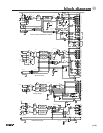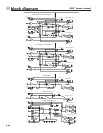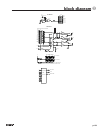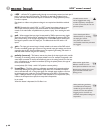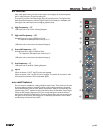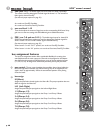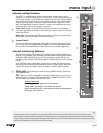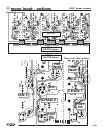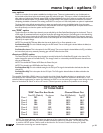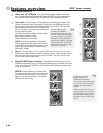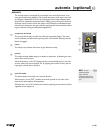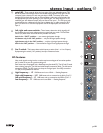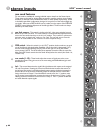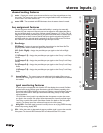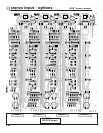
3
p. 19
mono input - options
user options
There are a number of user options available for the Mono inputs. These are implemented by way of solder-pads on
the back-side of the Mono Input circuit boards (upper EQ board of the pair). There are a number of solder-pads avail-
able, made up of split-circles of tinned copper. Solder is bridged (blobbed) across the 2 halves to complete the circuit and
implement the desired option. For the default setting, there is already a thin copper trace that connects the two halves,
completing the default connection. This existing trace MUST be cut (use an X-acto knife) before an option is implemented.
To change back to the default operation after an option was performed, remove the blobbed solder from the option
solder-pads (use a solder-sucker or solder-wick). Add a blob-link across the original, default pads to replace the thin trace
that was previously cut when the option was first performed.
aux “PRE” option
The Aux Sends on the Mono Input channels are normally fed by the Post-Fader/Post-Mute signal in the channel. There is
a PRE switch (3) associated with each set of Aux Sends that will change the feed to a Pre-Fader point in the channel’s sig-
nal path. There are two choices for this PRE point: Pre-Fader/Post-EQ and Pre-Fader/Pre-Insert.This change is done on a
channel-by-channel basis; each channel has its own set of solder-pads. All 3 of the PRE switches within that channel will be
affected by the option change.
NOTE: The channel MUTE always affects the Aux sends, whether Pre or Post, optioned or not.
Pre-Fader/Post-EQ: This is the default setting for the PRE switch. The aux send signal is derived before the fader, but
after the channel EQ.
Pre-Fader/Pre-Insert: This is the option for the PRE switch. The aux send signal is derived before the EQ, and before
the Insert Send jack, so any external processing gear will NOT affect the Aux sends.
direct out (D.O.) option
The Direct-Out jack on the Mono Input channels is normally fed by the Pre-Fader/Post-EQ signal in the channel. The
option changes this point to Pre-Fader/Pre-EQ. This change is done on a channel-by-channel basis; each channel has its
own set of solder-pads.
NOTE: The channel MUTE does NOT affect the Direct Out jack.
NOTE: The channel insert DOES affect the Direct Out jack.
Pre-Fader/Post-EQ: This is the default setting for the D.O. jack. The signal is derived before the fader, but after the
channel EQ.
Pre-Fader/Pre-EQ: This is the option for the D.O. jack. The D.O. signal is derived before the fader and before the
channel EQ.
The specified Solder-Blob (SBXX) shown in the table should be linked (by solder-bridging) to complete the circuit
and implement the indicated option. The table below shows the specific SBXX for each of the 8 channels on a cir-
cuitboard. Before implementing an option (by blobbing), be SURE to cut the existing thin copper trace linking the two
halves of the default SB. Failure to do so will result in channel operation problems and possible circuit damage.
HPW Mono Input
OPTIONS TABLE
“PRE” Feed For Aux Sends Channel Direct Out
Post-EQ (Default) Pre-Insert Post-EQ (Default) Pre-EQ
Chan-1 SB2 SB1 SB18 SB17
Chan-2 SB4 SB3 SB20 SB19
Chan-3 SB6 SB5 SB22 SB21
Chan-4 SB8 SB7 SB24 SB23
Chan-5 SB10 SB9 SB26 SB25
Chan-6 SB12 SB11 SB28 SB27
Chan-7 SB13 SB14 SB30 SB29
Chan-8 SB16 SB15 SB32 SB31
NOTE: The astute observer will notice that, because of the presence of the various solder-points within
the channel signal path, there are other possible connection options. For example: The Pre-EQ point that
is used for the DO option CAN be used to feed the Aux Pre circuits. Contact the factory for specific
information concerning non-standard options.



